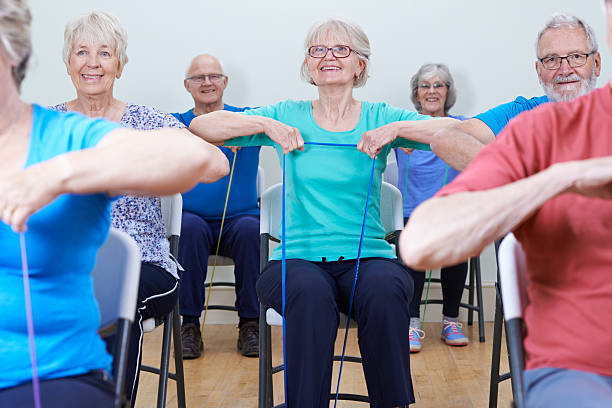Fitness Gadgets
Are Resistance Bands Good For Older Adults
Are resistance bands suitable for older adults? This is a common question among seniors who want to stay active and retain their strength. In short, the answer is an emphatic yes! Resistance bands are an excellent fitness tool for senior citizens for a variety of reasons.
Benefits of using resistance bands for older adults
Resistance bands have numerous benefits for older persons looking to increase their fitness and strength. For starters, resistance bands are soft on the joints, making them a safe choice for people who have arthritis or other mobility concerns. Unlike weights and machines, which put strain on the joints, resistance bands give a low-impact workout while successfully targeting and shaping muscles. This makes them a fantastic choice for seniors who want to be active while avoiding joint pain or injury.
Another advantage of employing resistance bands is that they can give varying resistance. This implies that seniors can vary the difficulty of their workout by simply changing the thickness or length of the band. This adaptability enables older folks to gradually build their strength and stamina over time without putting undue strain on their bodies. Resistance bands can be readily tailored to your fitness level, whether you’re a novice or an experienced exerciser.
Furthermore, resistance bands are very portable and practical. They are lightweight and take up little room, making it simple for older individuals to fit exercise into their daily routine. Resistance bands can be utilized almost anywhere, including at home, the gym, and while traveling. This convenience eliminates the need for costly gym memberships or heavy training equipment, making resistance bands an affordable and practical option for older individuals who want to keep healthy and active.

Types of resistance bands available
When it comes to resistance bands, there are various options. Each model provides distinct benefits and features that cater to a variety of fitness levels and interests. The following are the most frequent types of resistance bands offered for older adults:
- Loop bands: often called mini bands or booty bands, are little circular bands that can be wrapped around the legs or arms. They are commonly used for lower-body exercises like squats, lunges, and glute bridges. Loop bands provide various resistance levels, allowing seniors to progressively increase the intensity of their activities.
- Tube bands with handles: Tube bands with handles are long, flexible bands with handles at both ends. They are adaptable and may be used for a variety of exercises, including upper-, lower-, and core-based routines. Tube bands with grips are often designed with changing resistance levels, making them appropriate for seniors of all fitness levels.
- Figure-eight bands: Figure-eight bands are fashioned like the number eight and offer resistance when pushed apart. They are commonly used for upper-body exercises including chest presses, bicep curls, and shoulder lifts. Figure-eight bands provide more resistance than loop bands or tube bands with handles, making them perfect for seniors looking to improve upper-body strength.
- Therapy bands: also known as flat bands or rehab bands, are flat strips of elastic material that offer resistance. They are commonly utilized in physical therapy or rehabilitation programs to assist elders regain their strength and flexibility. Therapy bands come in a variety of resistance levels and are suitable for both upper and lower body activities.
How to choose the right resistance band for older adults
To ensure a safe and effective workout for older individuals, select the appropriate resistance band. Here are some aspects to consider while choosing a resistance band:
- Resistance level: Resistance bands vary in resistance, from mild to heavy. For beginners or seniors with limited strength, start with a lighter resistance band and work your way up to greater levels. It is critical to select a resistance level that tests but does not strain the muscles.
- Length and thickness: The length and thickness of the resistance band affect the amount of resistance it produces. Longer and thicker bands often give more resistance, whereas shorter and thinner bands provide less resistance. Seniors should select a band that allows them to complete activities with appropriate form and minimal strain.
- Quality and durability: It is critical to invest in high-quality resistance bands composed of durable materials. Cheaper bands may break or lose elasticity with time, posing a safety risk. Look for bands made of latex or other sturdy materials with reinforced stitching or grips for increased strength.
- Comfort and ease of use: Seniors should select a resistance band that feels good to use and does not cause discomfort or suffering. Bands with padded handles or non-slip surfaces can improve grip while reducing strain on the hands and joints. Furthermore, bands that are simple to change and secure during activities might improve the whole fitness experience.

Proper techniques and exercises using resistance bands for older adults
When working with resistance bands, it is critical to use suitable techniques and exercises. Here are some important guidelines for seniors to maximise the benefits of resistance band exercises:
- Warm-up: Before beginning any resistance band workout, warm up your muscles and joints. Light aerobic workouts or gentle stretches might help enhance blood flow and prepare the body for the activity.
- Proper form: Maintain good form throughout each exercise to achieve maximum efficacy and avoid injury. This includes keeping the core engaged, maintaining a neutral spine, and performing controlled motions. If you are unsure about proper form, see a fitness professional or view instructional videos.
- Gradual progression: Begin with lighter resistance bands, gradually increasing the intensity as your strength improves. It’s critical to test your muscles without overworking them. If an exercise feels too simple, consider switching to a higher resistance band.
- Full range of motion: To effectively target the muscles, perform workouts that cover the entire range of motion. This implies fully stretching and tightening the muscles with each repetition. Avoid jerky or partial movements, as these might cause imbalances and injuries.
- Breathing: Remember to breathe appropriately while performing resistance band activities. Inhale during the rest phase and exhale during the exertion stage. Proper breathing helps to oxygenate the muscles and improves overall function.
Safety precautions and considerations when using resistance bands
While resistance bands are generally healthy for older persons, it is crucial to use caution. Here are some recommendations for a safe workout:
- Start gently: If you’re new to resistance band exercises or haven’t exercised in a while, begin slowly and gradually increase your intensity. This helps the body to adapt while lowering the danger of overexertion or damage.
- Listen to your body: Pay close attention to how your body feels during and after each exercise. If you encounter pain, discomfort, or strange symptoms, stop exercising and contact with a doctor. It’s critical to recognize your body’s limitations and avoid pushing yourself too hard.
- Secure the band properly: Ensure that the resistance band is securely attached to a robust anchor point, such as a doorknob or a solid piece of furniture. This keeps the band from slipping or snapping during exercise.
- Avoid overstretching: Although resistance bands produce stress, they should not be stretched beyond their limits. Overstretching can cause the band to snap back, potentially resulting in injury. Follow the manufacturer’s directions for the maximum stretch limit of the band and do not exceed it.
- Stay hydrated: Drink plenty of water before, during, and after your resistance band workout. Staying hydrated is important for general health and can help prevent muscle cramps or weariness.

Incorporating resistance band exercises into a workout routine for older adults
To add resistance band workouts into a training program, you must first create a planned strategy. Here is an example resistance band fitness regimen for older adults:
- Warm-up: Begin with a 5- to 10-minute warm-up that involves light aerobic workouts like walking or cycling. This improves blood flow and prepares the muscles for the workout.
- Upper body exercises: Upper body exercises include bicep curls, tricep extensions, shoulder presses, and chest flies. Aim for 2-3 sets of 10-15 repetitions per exercise.
- Lower body exercises: Next, work on your legs, hips, and glutes. Squats, lunges, leg presses, and hip abductions are some examples of exercises. Again, aim for 2-3 sets of 10-15 reps per exercise.
- Core exercises: Include movements that work the core muscles, such as standing twists, seated twists, and plank variants. Perform 2-3 sets of 10-15 repetitions of each exercise.
- Stretching and cool-down: After the workout, perform a series of stretches to enhance flexibility and prevent muscular tightness. Stretch the primary muscle groups worked during the workout, holding each for 20-30 seconds.
Success stories and testimonials from older adults using resistance bands
Many older persons have reported considerable increases in their fitness and overall well-being after introducing resistance bands into their workout regimens. Here are a few success stories and testimonies from older folks who have used resistance bands:
- John, 65: “I started using resistance bands a few months ago and am delighted at the results. My strength and flexibility have significantly improved, and my joint pain has subsided. Resistance bands have become an indispensable element of my training regimen, and I wholeheartedly suggest them to other seniors.”
- Mary, 72: “After dealing with arthritis and restricted mobility, I was apprehensive to begin exercising again. But resistance bands were a game changer for me. They offer a gentle but effective workout that does not worsen my joint discomfort. I feel stronger and more invigorated after introducing resistance bands into my everyday routine.”
- Robert, 68: “Resistance bands have helped me keep active and strong despite my hectic schedule. I enjoy how portable and convenient they are. I can take them on trips or utilize them at home. Resistance bands have made fitness more accessible to me, and I couldn’t be happier with the results.
These success stories are just a few examples of how resistance bands have improved the lives of older people. With effort and regularity, seniors can reap similar benefits and improve their entire health and well-being.

Additional resources and tools for older adults using resistance bands
There are a variety of services and techniques accessible to older persons who want to incorporate resistance bands into their training program. Here are some more resources to explore:
- Online tutorials and videos: There are numerous online tutorials and videos that provide proper technique and workout ideas for using resistance bands. Websites like YouTube and fitness blogs provide a variety of free information that can be accessed from the convenience of one’s own home.
- Exercise apps: Many exercise apps now incorporate resistance band workouts tailored exclusively for older individuals. These apps give guided exercises, track progress, and make personalized recommendations based on users’ fitness levels and goals. Fitbod, Nike Training Club, and MyFitnessPal are some of the most popular fitness apps.
- Fitness classes and seminars: Local gyms, community centers, and senior centers frequently offer fitness programs or workshops that include resistance bands. These programs allow you to acquire proper methods, receive specific coaching, and interact with other like-minded people.
- Fitness professionals: Working with a trained fitness professional who specializes in senior fitness can provide helpful advice and support. A fitness professional may design a personalized resistance band training regimen based on your specific needs and goals, assuring optimal efficacy and safety.
Remember, always contact with a healthcare practitioner before beginning any new exercise regimen, especially if you have any underlying health conditions or concerns. They can offer specialized advise and solve any unique concerns or constraints you may have.
Conclusion
In conclusion, resistance bands are an excellent fitness tool for me as an older adult, providing a safe, effective, and convenient way to stay active and maintain strength. With their gentle impact on joints, variable resistance levels, and portability, resistance bands offer numerous benefits for seniors like me seeking to improve their fitness and overall well-being. Whether I’m a beginner or a seasoned exerciser, resistance bands can be easily incorporated into my workout routine and modified to suit my fitness level. So, if I’m a senior looking to improve my fitness, I’ll give resistance bands a try and experience the benefits for myself. I’ll stay active, stay strong, and enjoy the journey to a healthier me!


